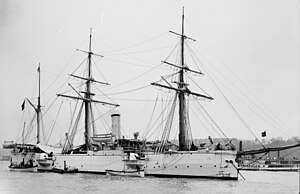 An unidentified Velasco-class (here called "Infanta Isabel-class") cruiser in U.S. waters during the 1880s or 1890s, showing the appearance of Gravina
| |
| History | |
|---|---|
| Name | Gravina |
| Namesake | Federico Carlos Gravina y Nápoli (1756–1806), Italian-Spanish admiral |
| Awarded | 1880 |
| Builder | Thames Ironworks & Shipbuilding & Engineering Co. Ltd., Leamouth, London, England |
| Laid down | 1881 |
| Launched | 27 July 1881 |
| Completed | 1881 |
| Fate | Wrecked 10 July 1884 |
| General characteristics | |
| Class and type | Velasco-class unprotected cruiser |
| Displacement | 1,152 tons |
| Length | 64.01 m (210 ft 0 in) |
| Beam | 9.75 m (32 ft 0 in) |
| Height | 5.33 m (17 ft 6 in)[1] |
| Draft | 4.17 m (13 ft 8 in) maximum |
| Depth | 3.86 m (12 ft 8 in)[1] |
| Installed power | 1,500 ihp (1,119 kW) |
| Propulsion | 1-shaft, horizontal compound, 4-cylinder boilers, 200 to 220 tons coal (normal) |
| Sail plan | |
| Speed | 13 knots (24 km/h; 15 mph) |
| Range | 2,000 nmi (3,700 km; 2,300 mi) |
| Complement | 173 officers and enlisted men |
| Armament |
|
Gravina was a Velasco-class unprotected cruiser of the Spanish Navy in service from 1881 to 1884. She was wrecked in a typhoon in 1884.
Characteristics and construction
[edit]Gravina was an iron-hulled unprotected cruiser[1] designed for colonial service in the Spanish Empire.[1] She was barque-rigged, with three masts and a bowsprit,[1] and she had one rather tall funnel. She and the lead ship of the class, Velasco, both built in the United Kingdom, were differently armed and slightly faster than the final six ships of the class, all of which were built in Spain. Gravina and Velasco were the first Spanish warships to be painted white.[2]
In 1880, the Spanish government signed a contract for the construction of Gravina with the Thames Ironworks & Shipbuilding & Engineering Co. Ltd. of Leamouth, London, in the United Kingdom.[2] Her keel was laid in 1881, and she was launched on 27 July 1881.[1] After her completion, she was delivered to the Spanish Navy later in 1881.[1]
Operational history
[edit]Gravina completed her delivery voyage to Spain with her arrival at Ferrol at the end of 1881.[1] She departed Ferrol on 2 January 1882 and, after a stop at Cartagena, deployed to the Philippines.[1]
On 26 October 1882, a Spanish squadron composed of Gravina, Velasco, the unprotected cruiser Aragón, the screw corvette Vencedora, the screw schooner Sirena, and the gunboats Arayak and Paragua 2 got underway from Manila for operations against the Jolo pirates, carrying a landing force consisting of 490 Spanish Marine Infantry personnel and naval infantrymen, 105 men of the Iberia Infantry Regiment, 111 men of the Jolo Infantry Regiment, and 100 men of a Manila disciplinary company.[1][2] After the squadron reconnoitered the coast, fighting began when the landing force went ashore at Looc on 29 October 1882.[2] On 30 October the Spanish force landed at Padang-Padang.[2] After conducting several raids, the troops returned to the ships and landed at Boal on 8 November 1882.[2] The squadron and troops returned to Manila in mid-November 1882.[1]
In November 1883 Gravina again was part of a squadron that mounted an expedition against the Jolo pirates.[1]
On 8 July 1884, Gravina departed Manila bound for Shanghai, China.[1] During the voyage, she encountered a typhoon and was wrecked on Fuga Island in the Babuyan Islands north of Luzon on 10 July 1884 with the loss of nine lives — two officers (an ensign and a midshipman) and seven enlisted men.[1][3] In a subsequent court martial her commanding officer, Capitán de fragata (Frigate Captain) José García de Quesada, was absolved of wrongdoing in her loss.[1]
References
[edit]Citations
[edit]- ^ a b c d e f g h i j k l m n o p "Gravina_(1882)". todoavante.es (in Spanish). 8 April 2022. Retrieved 14 January 2025.
- ^ a b c d e f "Velasco (1882)". todoavante.es (in Spanish). 26 April 2023. Retrieved 15 January 2025.
- ^ "Cable Notes". Chicago Tribune. 16 July 1884. Retrieved 25 June 2016 – via Newspapers.com.
Bibliography
[edit]- La Ilustración Española y Americana (in Spanish). No. XXXV. Madrid. 22 September 1884.
{{cite magazine}}: Missing or empty|title=(help) - Aguilera, Alfredo; Elías, Vicente (1980). Buques de guerra españoles, 1885-1971 (in Spanish). Madrid: Editorial San Martín.
- Bordejé y Morencos, Fernando de (1995). Crónica de la Marina española en el siglo XIX, 1868-1898 (in Spanish). Vol. II. Madrid: Ministry of Defence.
- Chesneau, Roger; Kolesnik, Eugene M. (1979). Conway's All The World's Fighting Ships 1860–1905. New York: Mayflower Books Inc. ISBN 0-8317-0302-4.
- Lledó Calabuig, José (1998). Buques de vapor de la armada española, del vapor de ruedas a la fragata acorazada, 1834-1885 (in Spanish). Agualarga Editores. pp. 96–98. ISBN 8495088754.
- Nofi, Albert A. (1996). The Spanish–American War, 1898. Conshohocken, Pennsylvania: Combined Books, Inc. ISBN 0-938289-57-8.
- Rivas Fabal, José Enrique (2007). Historia de la Infantería de Marina española Tomo II (in Spanish). Madrid: Ministry of Defense.
- VV.AA (1999). El Buque en la Armada española (in Spanish). Madrid: Editorial Sílex.
External links
[edit]- The Spanish–American War Centennial Website: Don Antonio de Ulloa
- Department of the Navy: Naval Historical Center: Online Library of Selected Images: Spanish Navy Ships: Conde del Venadito (Cruiser, 1888–1902)